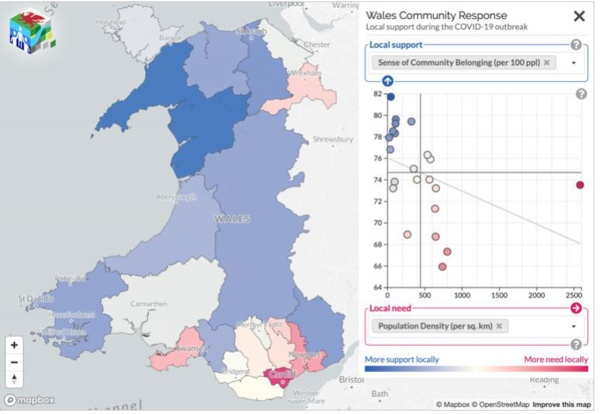New online tool aims to ensure that those most in need get support during pandemic
The COVID Response Map Wales highlights areas where there are higher numbers of people who are vulnerable to COVID-19, as well as areas where there may be less community support available.
It is designed to help agencies, public and third sector organisations better identify where there may be a need for greater support.
The interactive map was developed jointly by Public Health Wales’ Research and Evaluation Division, the MRC Integrative Epidemiology Unit at the University of Bristol and the Alan Turing Institute.
It works by mapping information on vulnerability, such as data on circulating COVID-19 cases and the number of people at high risk, against levels of citizen-led community support across Wales, as identified through social media sources, self-organising communities and third sector organisations.
It highlights the areas where there is a potential imbalance between support and need, where they could benefit from additional support.
Dr Alisha Davies, Head of Research & Evaluation at Public Health Wales, said:
“Since the start of the pandemic, there has been a huge increase in the number of people volunteering to help out in their local communities, from shopping for elderly neighbours, to offering a friendly face or other support.
“Bringing together openly available data on needs and support into this visual tool can help to inform discussions alongside localised intelligence to direct support to the vulnerable groups and communities that need it most.
“Whilst no single tool can provide a comprehensive picture of localised community response, much of which may not be online, this map does demonstrate the potential of bringing together different sources of data to help inform local intelligence on active community response in real time.”
Dr Oliver Davis, Associate Professor and Turing Fellow at Bristol Medical School and the Alan Turing Institute, said:
“Our research group was delighted to use its expertise in health data science in support of Public Health Wales, and we were encouraged to see that the data show communities rallying round in these challenging times. We are especially pleased that we were able to apply the principles of open science to help others working to manage the COVID-19 outbreak.”
Providing further insight into the increasing number of people across Wales stepping forward to volunteer, Ruth Marks, CEO of Wales Council for Voluntary Action (WCVA), said: “We’ve seen a remarkable response from volunteers during the crisis, with over 33,000 volunteers now registered on Volunteering Wales.
“There are many ways people have been volunteering. There are incredible examples of informal volunteering at a local level, and community support hubs being established and coordinated with the expert help of County Voluntary Councils (CVC’s) as well as more formal volunteering roles coordinated through volunteering-wales.net.
“The COVID response map tool will now help to ensure that resources are allocated to those who need volunteer support as we continue into the next phases of the pandemic.”
You can view the COVID Response Map Wales online here.
